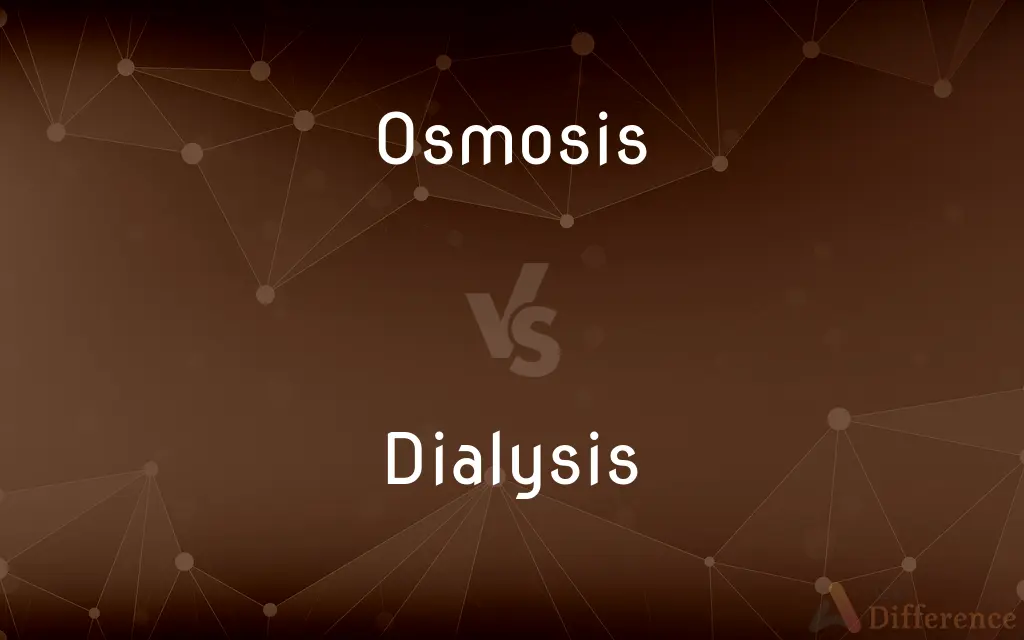Osmosis vs. Dialysis — What's the Difference?
By Tayyaba Rehman — Published on December 3, 2023
Osmosis is the movement of solvent molecules through a semipermeable membrane from a less concentrated solution to a more concentrated one, while Dialysis is a process where solutes are separated from a solvent using a semipermeable membrane.

Difference Between Osmosis and Dialysis
Table of Contents
ADVERTISEMENT
Key Differences
Osmosis is a passive movement of water or other solvents across a semipermeable membrane. It occurs from a region of low solute concentration to high concentration. Dialysis, on the other hand, involves the separation of small solutes from a solvent using a similar membrane. Both processes use a membrane, but their objectives differ.
In biological systems, Osmosis plays a vital role in maintaining cellular hydration and nutrient balance. Cells regulate their internal environment by controlling water movement via osmosis. Dialysis is commonly known for its medical application, particularly in patients with kidney failure, where it filters and purifies the blood.
The principle behind Osmosis is equilibrium; it continues until the concentration of solutes is equal on both sides of the membrane. Dialysis operates under a similar principle but focuses on the removal of unwanted solutes, ensuring purified solvents.
Osmosis requires no external energy for the process to occur, as it is a result of natural solvent concentration gradients. Dialysis, while also a passive process, might need external machinery, especially in medical settings, to aid in the separation of solutes from solvents.
At its core, Osmosis is about balance and equalization, ensuring cells and systems maintain their required hydration and solute levels. Dialysis, while utilizing similar concepts, is more about purification and removal of unwanted substances from a system.
ADVERTISEMENT
Comparison Chart
Process Type
Passive movement
Separation process
Focus
Solvent movement
Solute separation
Energy Requirement
No external energy
Might need external machinery
Objective
Equilibrium of solute concentration
Purification of solvent
Main Application
Cellular hydration/nutrient balance
Medical (e.g., kidney treatment)
Compare with Definitions
Osmosis
Passive process driven by concentration differences.
Osmosis in red blood cells regulates their size and shape.
Dialysis
External procedure aiding the natural filtering function of kidneys.
Dialysis machines act as artificial kidneys for those in need.
Osmosis
Movement of solvent molecules across a semipermeable membrane.
Osmosis helps plant cells gain water from the soil.
Dialysis
Medical process to purify blood in kidney failure patients.
Patients with severe kidney issues might require regular dialysis treatments.
Osmosis
Occurs until equilibrium of solute concentration is achieved.
Osmosis stops when the inside and outside of the cell have equal solute concentrations.
Dialysis
Often requires machinery and clinics for treatment.
Regular visits to a dialysis clinic are essential for some patients to maintain health.
Osmosis
Fundamental to various biological systems and processes.
Osmosis in the roots of plants allows them to absorb water from the ground.
Dialysis
Separation of solutes from solvents using a semipermeable membrane.
Dialysis can separate unwanted substances from the blood.
Osmosis
Diffusion of fluid through a semipermeable membrane from a solution with a low solute concentration to a solution with a higher solute concentration. Osmosis ceases when there is an equal solute concentration on both sides of the membrane.
Dialysis
Utilizes principles similar to osmosis but focuses on solute removal.
While osmosis balances concentrations, dialysis aims to remove specific solutes.
Osmosis
The tendency of fluids to diffuse in such a manner.
Dialysis
The separation of smaller molecules from larger molecules or of dissolved substances from colloidal particles in a solution by selective diffusion through a semipermeable membrane.
Osmosis
A gradual, often unconscious process of assimilation or absorption
Learned French by osmosis while residing in Paris for 15 years.
Dialysis
(Medicine) Any of several techniques, especially hemodialysis and peritoneal dialysis, in which filtration through a semipermeable membrane is used to remove metabolic wastes and excess fluid from the blood of people with kidney failure.
Osmosis
(chemistry) The net movement of solvent molecules, usually water, from a region of lower solute concentration to a region of higher solute concentration through a partially permeable membrane.
Dialysis
(chemistry) A method of separating molecules or particles of different sizes by differential diffusion through a semipermeable membrane.
Osmosis
(figurative) Passive absorption or impartation of information, habits, etc.; the act of teaching or picking up knowledge incidentally, without actually seeking that particular knowledge.
I was reading about chickens, and I guess I learned about hawks through osmosis.
Dialysis
(medicine) Utilization of this method for removal of waste products from the blood in the case of kidney failure: hemodialysis or peritoneal dialysis.
Artificial kidney
Osmosis
The tendency in fluids to mix, or become equably diffused, when in contact. It was first observed between fluids of differing densities, and as taking place through a membrane or an intervening porous structure. An older term for the phenomenon was Osmose.
Dialysis
(rhetoric) The spelling out of alternatives, or presenting of either-or arguments that lead to a conclusion.
Osmosis
Diffusion of molecules through a semipermeable membrane from a place of higher concentration to a place of lower concentration until the concentration on both sides is equal
Dialysis
(rhetoric) Asyndeton.
Osmosis
Key mechanism for cellular hydration and homeostasis.
Without osmosis, cells would either shrivel up or burst.
Dialysis
Diæresis. See Diæresis, 1.
Dialysis
Same as Asyndeton.
Dialysis
Debility.
Dialysis
The separation of different substances in solution, as crystalloids and colloids, by means of their unequal diffusion, especially through natural or artificial membranes.
Dialysis
Separation of substances in solution by means of their unequal diffusion through semipermeable membranes
Common Curiosities
How does Osmosis benefit cells?
Osmosis regulates cell hydration, ensuring they don't shrivel up or burst due to water imbalances.
Is the membrane essential for both Osmosis and Dialysis?
Yes, a semipermeable membrane is fundamental for both Osmosis and Dialysis processes.
What stops the process of Osmosis?
Osmosis stops when there's an equilibrium of solute concentration on both sides of the membrane.
In which setting is Dialysis commonly applied?
Dialysis is commonly applied in medical settings, especially for patients with kidney dysfunctions.
What drives the process of Osmosis?
Osmosis is driven by differences in solute concentrations on either side of a membrane.
Is Dialysis only a medical term?
While Dialysis is most commonly associated with medical treatments, it's a general term for the separation of solutes from solvents using a membrane.
Do Osmosis and Dialysis both require external energy?
Osmosis doesn't require external energy, while Dialysis might require machinery, especially in medical contexts.
Can Dialysis function without machinery?
In principle, Dialysis is a passive process, but in many applications, especially medical, machinery aids the process.
Does Osmosis involve the movement of solutes?
Osmosis primarily concerns the movement of solvents, not solutes.
Does Osmosis always move water from a less concentrated to a more concentrated solution?
Yes, Osmosis inherently moves solvents from areas of low solute concentration to high concentration.
Why is Dialysis crucial for some patients?
Dialysis performs the filtering function of the kidneys, purifying the blood for patients with kidney failure.
Is Osmosis only relevant in biology?
While Osmosis is a fundamental biological process, the principle can be observed in other scientific contexts.
Can Dialysis be seen outside of human medical contexts?
Yes, Dialysis can be used in labs and other settings for solute separation from solvents.
Do Osmosis and Dialysis both achieve equilibrium?
Osmosis aims for equilibrium of solute concentrations, while Dialysis focuses on solute removal, not necessarily equilibrium.
What's a common device associated with Dialysis?
A common device associated with Dialysis is the "dialysis machine," used in medical treatments.
Share Your Discovery

Previous Comparison
Spores vs. Seeds
Next Comparison
Government School vs. Private SchoolAuthor Spotlight
Written by
Tayyaba RehmanTayyaba Rehman is a distinguished writer, currently serving as a primary contributor to askdifference.com. As a researcher in semantics and etymology, Tayyaba's passion for the complexity of languages and their distinctions has found a perfect home on the platform. Tayyaba delves into the intricacies of language, distinguishing between commonly confused words and phrases, thereby providing clarity for readers worldwide.












































